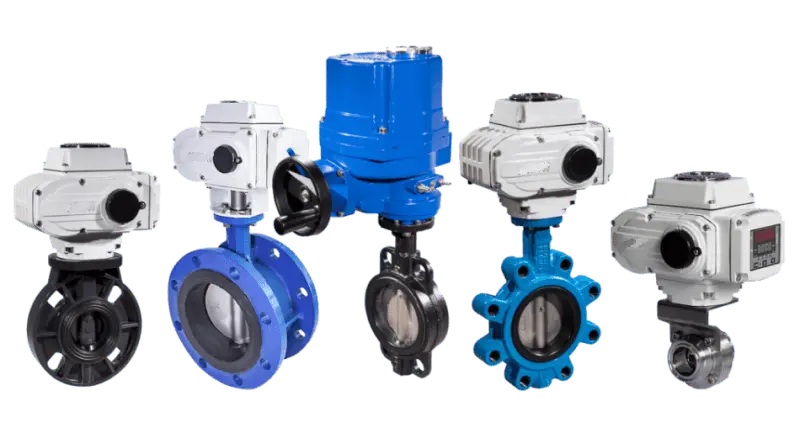Introduction
We are a leading control valve manufacturer in China, specializing in high-performance valves and precision control actuators engineered to meet a wide range of industrial applications.
In today’s automated industrial landscape, electric butterfly valves play a pivotal role in regulating fluid flow across a wide range of applications—from water treatment and HVAC to oil & gas, power generation, and chemical processing. As demand grows for precise, responsive process control, the performance of these valves increasingly depends on the electric actuators that drive them.
Selecting the correct actuator involves much more than matching voltage or torque ratings. It requires a comprehensive understanding of valve design, process conditions, environmental challenges, and operational demands. An incorrectly sized or mismatched actuator can result in poor valve performance, increased energy consumption, equipment wear, or even system failure.
This guide provides a step-by-step framework for engineers, maintenance teams, and procurement professionals to select electric actuators for butterfly valves with confidence and precision.
Why Proper Actuator Sizing Matters
The actuator is the mechanical force behind the valve’s movement, converting electrical energy into rotational motion to open, close, or modulate the valve disc. Undersized actuators may struggle to fully close or open the valve, while oversized ones can lead to excessive wear, higher costs, and inefficient energy use.
Proper sizing ensures:
- Reliable and consistent valve operation
- Extended service life for valve and actuator
- Lower maintenance frequency and operational costs
- Optimal energy efficiency
- Compliance with application-specific requirements (e.g., explosion-proof, high-cycle operations)
Key Considerations for Selecting Electric Actuators for Butterfly Valves
1. Determine Valve Operating Torque
Torque is the primary factor in actuator selection. It represents the force required to rotate the valve disc against resistance from pressure, seat friction, fluid characteristics, or debris buildup.
Influencing Factors:
- Valve size and type
- Sealing material
- Pressure and fluid velocity
- Media characteristics (viscosity, debris, temperature)
- Age and wear of the valve
Recommendation:
Always choose an actuator rated for 1.2 to 1.5 times the maximum operating torque of the valve. For example, if your valve requires 80 Nm, select an actuator with 100–120 Nm output torque for safe operation.
2. Consider Valve Size and Design
- Valve Diameter: Torque requirements increase significantly with size. A DN300 valve may need 10x more torque than a DN50.
- Valve Configuration:
- Concentric (midline) valves generate more friction due to constant disc-seat contact.
- Double- and triple-offset valves reduce friction, decreasing torque demands by up to 50%.
- Seat Type:
- Soft-seated valves typically need less torque.
- Metal-seated valves are more robust but require higher torque, especially under high temperature or pressure.
Tip: Use manufacturer torque curve data for accurate figures rather than relying on assumptions.
3. Evaluate Medium and Process Conditions
- Viscosity: Thick or slurry-like fluids demand more torque. Increase the safety margin by 15%–25% in such cases.
- Temperature: High process temperatures (>80°C) may degrade actuator components. Use actuators rated for high-heat applications with thermal protection features.
- Corrosive Media: Ensure actuator housing and internals are resistant to chemical exposure, potentially using coatings or specialty materials.
- Pressure Fluctuations: Dynamic pressure changes can increase the force needed to maintain control. Factor these into your torque calculation.
4. Assess Environmental and Safety Requirements
- Hazardous Locations: For use in explosive environments (e.g., chemical plants, refineries), actuators must be explosion-proof with certifications like Ex d IIC T6.
- Ingress Protection: For outdoor or wet environments, IP67 or IP68-rated enclosures protect against water and dust intrusion.
- Extreme Temperatures: In cold areas, actuators may require built-in heaters or insulation to maintain functionality.
Four-Step Actuator Selection Process
Step 1: Gather Valve Specifications
Obtain detailed data including:
- Valve type and model
- Nominal diameter (DN)
- Pressure class (PN)
- Sealing material
- Medium type (liquid, gas, corrosive, abrasive)
- Operating pressure and temperature
- Flow characteristics (throttling vs. on/off)
Step 2: Calculate Required Torque
Use the valve manufacturer’s torque curve across the full cycle (especially for modulating applications). In absence of data, you can measure torque manually during a full open/close cycle using a torque wrench.
Don’t forget to include:
- Safety margin (×1.2–1.5)
- Additional torque for aging valves, deposits, or high-viscosity fluids
Step 3: Match Actuator Specifications
- Torque Rating: Choose based on calculated torque × safety factor
- Power Supply: Confirm actuator voltage matches plant standards (e.g., AC 220V, 380V, DC 24V)
- Control Type:
- On/Off: For simple open/close functions
- Modulating: For continuous positioning via 4–20 mA or 0–10 V signal
Step 4: Verify Application Requirements
Before finalizing selection:
- Check explosion-proof certifications if required
- Evaluate operating frequency—select heavy-duty models for high-cycle operations
- Ensure appropriate IP rating and corrosion resistance
- Consider manual override mechanisms for emergency operation
Additional Best Practices
Partner with Trusted Suppliers
Work with reputable actuator manufacturers who can provide:
- Accurate torque sizing support
- Customization for specific applications
- Technical documentation and after-sales support
Integrate Safety and Diagnostics
- Use position feedback sensors (analog or digital)
- Add torque limiters and overload protection
- Consider remote monitoring via intelligent (smart) actuators
Plan for Maintenance
- Regularly inspect seals, couplings, and electronics
- Follow manufacturer-recommended lubrication and servicing intervals
Conclusion
Choosing the right electric actuator for your butterfly valve is a critical decision that directly impacts system reliability, safety, and efficiency. By following a structured selection process—starting with torque calculation and moving through operational and environmental considerations—you can ensure your valve-actuator assembly delivers optimal performance over the long term.
Investing time in proper actuator sizing pays off with lower maintenance costs, improved energy efficiency, and reduced risk of operational failure—making it an essential best practice in modern process control systems. Know more about Google SEO Directory





Comments